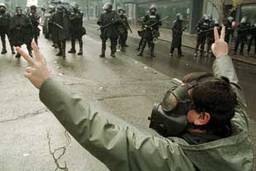
The low, flat-topped hills of south Orissa have been home to the Dongria Kondh long before there was a country called India or a state called Orissa. The hills watched over the Kondh. The Kondh watched over the hills and worshipped them as living deities. Now these hills have been sold for the valuable bauxite they contain. For the Kondh it’s as though god had been sold. They ask how much god would go for if the god were Ram or Allah or Jesus Christ.
Perhaps the Kondh are supposed to be grateful that their Niyamgiri Hills, home to their Niyam Raja, God of Universal Law, have been sold to a company with a name like Vedanta (named for the branch of Hindu philosophy that teaches the Ultimate Nature of Knowledge). It’s one of the biggest mining corporations in the world and is owned by Anil Agarwal, the Indian billionaire who lives in London in a mansion that once belonged to the Shah of Iran. Vedanta is only one of the many multinational corporations closing in on Orissa.
If the flat-topped hills are destroyed, the forests that clothe them will be destroyed, too. So will the rivers and streams that flow out of them and irrigate the plains below. So will the Dongria Kondh. So will the hundreds of thousands of tribal people who live in the forested heart of India, and whose homeland is similarly under attack.
In India’s smoky, crowded cities, some people say, “So what? Someone has to pay the price of progress.” Some even say, “Let’s face it, these are people whose time has come. Look at any developed country – Europe, the United States, Australia – they all have a ‘past.’ ” Indeed they do. So why shouldn’t “we”?
In keeping with this line of thought, on Dec. 3, 2009, the government launched Operation Green Hunt, a war purportedly against the Maoist rebels headquartered in the jungles of central India. The war is scheduled to last five years and deploy up to 70,000 police and para-military troops. Of course, the Maoists are by no means the only ones rebelling. There is a whole spectrum of struggles all over the country that people are engaged in – the landless, the Dalits, the homeless, workers, peasants, weavers. They’re pitted against a juggernaut of injustices, including policies that allow a wholesale corporate takeover of people’s land and resources. However, it is the Maoists that the government has singled out as being the biggest threat.
Two years ago, when things were nowhere near as bad as now, Prime Minister Manmohan Singh described the Maoists as the “single largest internal security threat” to the country. This will probably go down as the most popular and oft-repeated thing he ever said. For some reason, the comment he made at a January 2009 meeting of state chief ministers, when he described the Maoists as having only “modest capabilities,” doesn’t seem to have had the same raw appeal. He revealed his government’s real concern later that year in June, when he told parliament: “If left-wing extremism continues to flourish in parts which have natural resources of minerals, the climate for investment would certainly be affected.”
Maoist insurgents
Who are the Maoists? They are members of the banned Communist Party of India (Maoist), also known as CPI (Maoist) – one of the several descendants of the Communist Party of India (Marxist-Leninist), which led the 1969 Naxalite uprising and was subsequently liquidated by the Indian government. The Maoists believe that the innate, structural inequality of Indian society can only be redressed by the violent overthrow of the Indian state. In its earlier avatars as the Maoist Communist Centre (MCC) in Jharkhand and Bihar, and the People’s War Group (PWG) in Andhra Pradesh, the Maoists had tremendous popular support. (When the ban on them was briefly lifted in 2004, 1.5 million people attended their rally in Warangal.)
Their intercession in Andhra Pradesh ended badly. They left a violent legacy that turned some of their staunchest supporters into harsh critics. After a paroxysm of killing and counter-killing by the Andhra Pradesh police as well as the Maoists, the PWG was decimated. Those who managed to survive fled the state of Andhra Pradesh to the neighboring state of Chhattisgarh, where, deep in the heart of the forest, they joined colleagues who had already been there for decades.
Not many outsiders have first-hand experience of the Maoist movement in the forest. A recent interview in Open, an Indian weekly magazine, with its top leader, Comrade Ganapathy (born Mupalla Laxman Rao), didn’t do much to change the minds of those who view the Maoists as a party with an unforgiving, totalitarian vision that countenances no dissent whatsoever. Comrade Ganapathy said nothing that would persuade people that, were the Maoists ever to come to power, they would be equipped to properly address the almost insane diversity of India’s caste-ridden society. His casual approval of the Liberation Tigers of Tamil Eelam (LTTE) of Sri Lanka was enough to send a shiver down even the most sympathetic of spines, not just because of the brutal ways in which the LTTE chose to wage its war, but also because of the cataclysmic tragedy that has befallen the Tamil people of Sri Lanka, who it claimed to represent, and for whose fate it surely must take some responsibility.
Right now in central India, the Maoists’ guerrilla army is made up almost entirely of desperately poor tribal people living in conditions of chronic hunger we only associate with sub-Saharan Africa. They are people who, even after 60 years of India’s so-called independence, have not had access to education, healthcare or legal redress. They are people who have been mercilessly exploited for decades, consistently cheated by small businessmen and moneylenders, the women raped as a matter of right by police and forest department personnel. Their journey back to a semblance of dignity is due in large part to the Maoist cadre who have lived and worked and fought by their side for decades.
In 2008, an expert group appointed by the Planning Commission submitted a report called “Development Challenges in Extremist-Affected Areas”. It said:
The Naxalite (Maoist) movement has to be recognized as a political movement with a strong base among the landless and poor peasantry and adivasis [India’s indigenous people]. Its emergence and growth need to be contextualized in the social conditions and experience of people who form a part of it. The huge gap between state policy and performance is a feature of these conditions. Though its professed long-term ideology is capturing state power by force, in its day-to-day manifestation, it is to be looked upon as basically a fight for social justice, equality, protection, security and local development
A very far cry from the country’s “single-largest internal security threat.”
The Planning Commission report went on to conclude, “[S]ince the goals of the movement are political, it has to be addressed politically. Negotiation is the only political instrument of such a response in a democracy.”
Nobody listened.
Warcraft à la Sri Lanka
In order to keep its better-off citizens absolutely safe from these dangerous people, the government has declared war on them. A war which, it tells us, may take between three and five years to win. Odd, isn’t it, that even after the 2008 Mumbai attacks, the government was prepared to talk with Pakistan? But when it comes to waging war against the poor, it’s playing hardball.
It’s not enough that special police with totemic names like Greyhounds, Cobras and Scorpions are scouring the forests with a license to kill. It’s not enough that the Central Reserve Police Force (CRPF), the Border Security Force (BSF) and the notorious Naga Battalion have already wreaked havoc and committed unconscionable atrocities in remote forest villages. It’s not enough that the government supports and arms the Salwa Judum (Purification Hunt), a private vigilante “people’s militia” that has killed and raped and burned its way through the forests of the Dantewada District, Chhattisgarh, leaving 300,000 people homeless or on the run. Now, as of Dec. 3, 2009, the government has commenced Operation Greenhunt.
Operation Greenhunt is deploying the Indo-Tibetan border police and tens of thousands of paramilitary troops. It will set up a brigade headquarters in the Bilaspur District (displacing nine villages) and an air base in the Rajnandgaon District (displacing seven). The helicopters of the Indian air force have been given the right to fire in “self-defense” – a right the government denies its poorest citizens.
Fire at whom? How will the security forces be able to distinguish a Maoist from an ordinary person who is running terrified through the jungle? Will adivasis carrying the bows and arrows they have carried for centuries now count as Maoists too? Are non-combatant Maoist sympathizers valid targets? When I was in Dantewada, the superintendent of police showed me pictures of 19 “Maoists” that “his boys” had killed. I asked him how I was supposed to tell they were Maoists. He said, “See Ma’am, they have malaria medicines, Dettol bottles, all these things from outside.”
What kind of war is Operation Green Hunt going to be? Will we ever know? Not much news comes out of the forests. Lalgarh in West Bengal has been cordoned off. Those who try to go in are being beaten and arrested. And called Maoists, of course.
In the space of a few hours on May 17, 2009, in Dantewada, 500 government security forces bulldozed out of existence the Vanvasi Chetana Ashram, a Gandhian ashram. It was the last neutral outpost before the war zone begins, a place where journalists, activists, researchers and fact-finding teams could stay while they worked in the area.
Meanwhile, the Indian establishment has unleashed its most potent weapon. Almost overnight, our embedded media has substituted its steady supply of planted, unsubstantiated, hysterical stories about “Islamist terrorism” with planted, unsubstantiated, hysterical stories about “Red terrorism.” In the midst of this racket, at ground zero, the cordon of silence is being inexorably tightened.
The “Sri Lanka solution” could very well be in the cards. It’s not for nothing that the Indian government blocked a European move in the UN asking for an international probe into war crimes committed by the government of Sri Lanka in its recent offensive against the Tamil Tigers.
The first move in that direction is the concerted campaign that has been orchestrated to shoehorn the myriad forms of resistance taking place in this country into a simple George Bush binary: If you are not with us, you are with the Maoists. The deliberate exaggeration of the Maoist “threat” helps the state justify militarization. While all the oxygen is being used up by this new doppelganger of the “war on terror,” the state will use the opportunity to mop up the hundreds of other resistance movements in the sweep of its military operation, calling them all Maoist sympathizers.
Once the war begins, like all wars, it will develop a momentum, a logic and an economics of its own. It will become a way of life, almost impossible to reverse. The police will be expected to behave like an army, a ruthless killing machine. The paramilitary will be expected to become like the police, a corrupt, bloated administrative force. We’ve seen it happen in the states of Nagaland, Manipur and Kashmir. The only difference in the “heartland” will be that it will become obvious very quickly to the security forces that they’re only a little less wretched than the people they’re fighting. In time, the divide between the people and the law enforcers will become porous. Guns and ammunition will be bought and sold. In fact, it’s already happening. Whether it’s the security forces or the Maoists or noncombatant civilians, the poorest people will die in this rich people’s war.
Precious metal
So what kind of money are we talking about? In their soon-to-be-published book, Out of This Earth: East India Adivasis and the Aluminum Cartelj, Samarendra Das and Felix Padel write that the financial value of the bauxite deposits in the state of Orissa alone is $2.27 trillion (more than twice India’s GDP). That was at 2004 prices. Today, it would be about $4 trillion.
Beyond Orissa, expand the $4 trillion to include the value of the millions of tons of high-quality iron ore in the states of Chhattisgarh to the west and Jharkhand to the north, and the 28 other precious mineral resources, including uranium, limestone, dolomite, coal, tin, granite, marble, copper, diamond, gold, quartzite, corundum, beryl, alexandrite, silica, fluorite, and garnet. Add to that the power plants, the dams, the highways, the steel and cement factories, the aluminum smelters, and all the other infrastructure projects to estimate the scale of the operation and the desperation of the stakeholders. Often, if the mining company is a known and recognized one, the chances are that, even though the ore is still in the mountain, it will have already been traded on the futures market.
There are contracts on every mountain, river and forest glade. We’re talking about social and environmental engineering on an unimaginable scale. And most of this is secret. It’s not in the public domain. Our 24-hour news channels that are so busy hunting for macabre stories of Maoist violence – and making them up when they run out of the real thing – seem to have no interest at all in this side of the story. I wonder why?
Perhaps it’s because the development lobby to which they are so much in thrall says the mining industry will ratchet up the rate of GDP growth dramatically and provide employment to the people it displaces. This does not take into account the catastrophic costs of environmental damage. But even on its own narrow terms, it is simply untrue. Most of the money goes into the bank accounts of the mining corporations. A very tiny percentage of the displaced people get jobs, and those who do, earn slave-wages to do humiliating, backbreaking work. By caving in to this paroxysm of greed, we are bolstering other countries’ economies with our ecology.
When the scale of money involved is what it is, the stakeholders are not always easy to identify. Between the CEOs in their private jets and the wretched tribal special police officers in the “people’s” militias – who for a couple of thousand rupees a month fight their own people, rape, kill and burn down whole villages in an effort to clear the ground for mining – there is an entire universe of primary, secondary and tertiary stakeholders.
These people don’t have to declare their interests, but they’re allowed to use their positions and good offices to further them. How will we ever know which political party, which ministers, which MPs, which politicians, which judges, which NGOs, which expert consultants, which police officers, have a direct or indirect stake in the booty? How will we know which newspapers reporting the latest Maoist “atrocity,” which TV channels “reporting directly from ground zero” – or, more accurately, making it a point not to report from ground zero, or even more accurately, lying blatantly from ground zero – are stakeholders?
Too many questions about conflicts of interest and cronyism remain unanswered. What are we to make of the fact that the Minister of Home Affairs P. Chidambaram, the chief of Operation Green Hunt, was a non-executive director of the mining company Vedanta – a position from which he resigned the day he became finance minister in 2004? What are we to make of the fact that, when he became finance minister, one of the first clearances he gave to allow foreign direct investment in India was to Twinstar Holdings, a Mauritius-based company, to buy shares in Sterlite, a part of the Vedanta group?
What are we to make of the fact that, when activists from Orissa filed a case against Vedanta in the Supreme Court of India, citing its violations of government guidelines and pointing out that the Norwegian Pension Fund had withdrawn its investment from the company alleging gross environmental damage and human rights violations committed by the company, Justice S.H. Kapadia suggested that Vedanta be substituted with Sterlite? He then blithely announced in an open court that he, too, had shares in Sterlite. He gave forest clearance to Sterlite to go ahead with the mining, despite the fact that the supreme court’s own expert committee had explicitly said that permission should be denied and that mining would ruin the forests, water sources, environment and the lives and livelihoods of the thousands of tribal people living there.
What are we to make of the fact that just around the time Prime Minister Singh began to call the Maoists the “single largest internal security threat” (a signal that the government was getting ready to go after them), the share prices of many of the mining companies in the region skyrocketed?
The mining companies desperately need this war. They will strike it rich, very rich, if the Indian government’s counterinsurgency operations successfully evict the tribal people who have so far managed to resist the attempts to drive them from their ancestral lands.
But whether the coffers of the mining corporations will overflow, or whether Operation Green Hunt simply swells the ranks of the Maoists, remains to be seen.
This story was adapted from a longer article, “The Heart of India is Under Attack,” first published by The Guardian of the U.K.
The photographs are provided courtesy of Survival: The Movement for Tribal Peoples.








